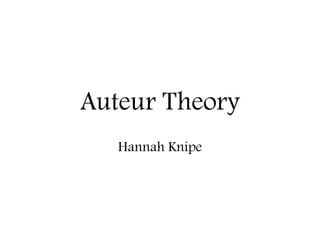
Auteur Theory: Directors' Personal Style
- 2. About Auteur Theory • In 1954, François Truffaut wrote an essay entitled A Certain Tendency in French Cinema. In this work he claimed that film is a great medium for expressing the personal ideas of the director. He suggested that this meant that the director should therefore be regarded as an auteur. In fact, Truffaut once provocatively said that: "There are no good and bad movies, only good and bad directors”. • The worth of this theory has been questioned by some critiques. But, it is particularly useful as a starting point for the interpretation of some films. Auteur Theory suggests that a director can use the commercial apparatus of film-making in the same way that a writer uses a pen or a painter uses paint and a paintbrush. It is a medium for the personal artistic expression of the director. The film theorotician, André Bazin, explained that: auteur theory was a way of choosing the personal factor in artistic creation as a standard of referencce, and then assuming that it continues and even progresses from one film to the next. Sometimes this theory is useful when analysing the works of actors who are working within the ‘star system’. For example, it is possible to interpret Terminator 3 in relation to the canon of films created with Arnie in them. Auteur Theory suggests that the best films will bear their maker’s ‘signature’. Which may manifest itself as the stamp of his or her individual personality or perhaps even focus on recurring themes within the body of work. Alfred Hitchcock plays this idea up in most of his movies where he makes sure that he appears on screen in a brief cameo spot. This became a game that viewers would engage in, waiting to find out when he would appear.
- 3. Definition • Auteur is when a director, reflects their own style, vision, techniques, innovation, personality, creativity, into all the films that they direct. The themes within each film will be similar. This allows the audience to recognise which film is produced by which director.
- 4. Auteurs • There are many different auteurs and many that will be recognised such as Alfred Hitchcock, Steven Spielberg, Tim Burton, David Lynch, Woody Allen and Martin Scorsese.
- 5. Alfred Hitchcock • Alfred Hitchcock is one of the first names who comes to mind when talking about auteur theory. His most famous films are Vertigo, Psycho, The Birds and Rear Window. Hitchcock’s story telling techniques were renowned for their intelligent plots, witty dialogue, and the smattering of mystery and murder. He has been attributed with revolutionizing the thriller genre. • The reason for his success, however, was not the genre that he was working in, but rather the skill which he exhibited in the film-making. i.e. his treatment of the subject in terms of the shots he uses and how he combines them are more important than the genre. One of Hitchcock’s best-known screen moments is the terrifying shower scene in Psycho. This shot features 70 distinct shots in less than 1 minute. They are fused together in such a way that it is difficult to distinguish between the Montage and the Mise-en-Scène. • Montage: putting together the shots of the film (also known as cutting or editing). This term is used to suggest that the meaning of two different shots can create a deeper meaning by the juxtaposition of the images. Montage is useful in conveying a lot of information over a very short period of time. • Mise-en-Scène: the term used to describe what actually goes into a shot and how the camera shoots it. One of the themes that recurs quite frequently is the idea that innocent people can get caught up in circumstances beyond their control. Sometimes the characters are guilty of lesser crimes than the ones they are accused of but they are innocent of the crimes that are being attributed to them. • He soon caught the attention of Hollywood and he was lured there in the 1940s. Hitchcock became a household name with his TV series called Alfred Hitchcock Presents which ran for a decade (1955-1965). His particular voice, his body shape, and his eccentric mannerisms became instantly recognizable most of his ‘thrillers’ owe a lot to the power of suspense. As a director, he leans towards a presentation style which lets the audience into more than he lets his characters into.